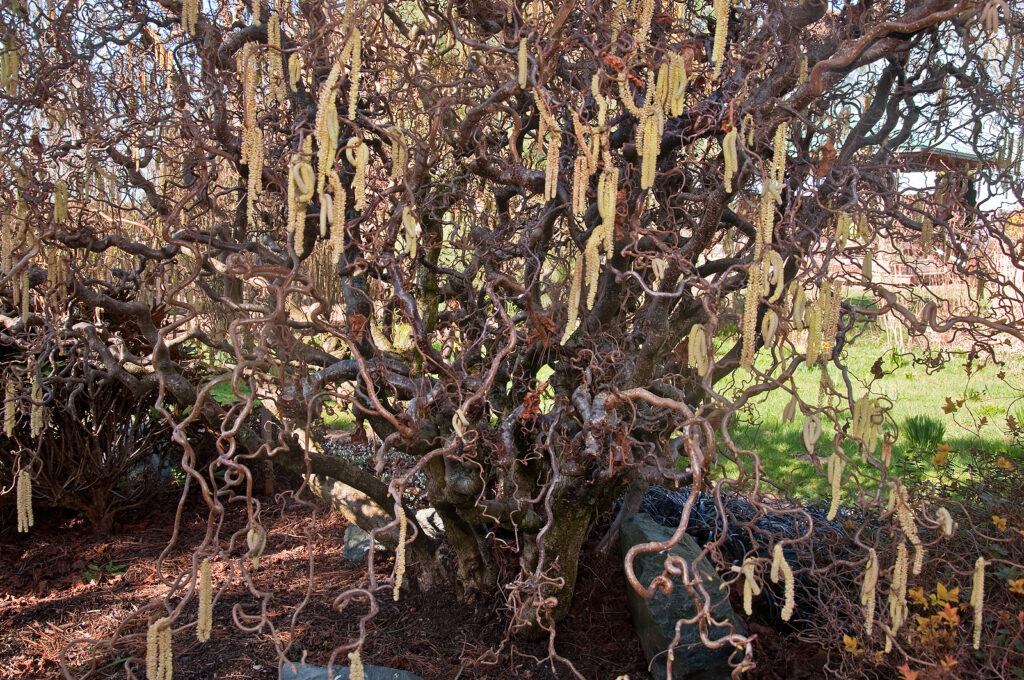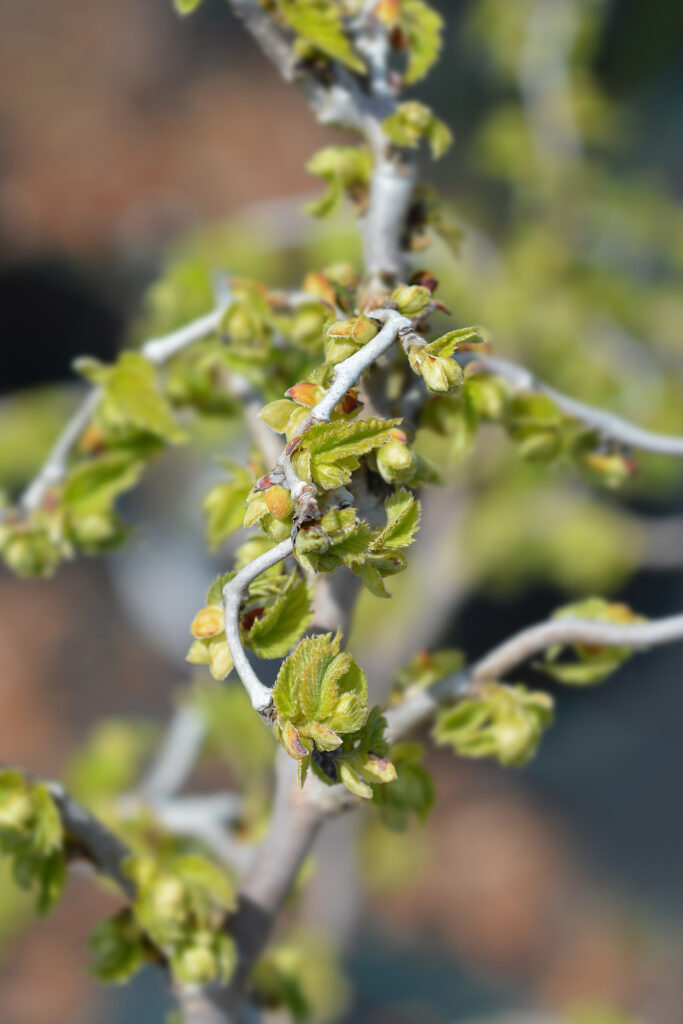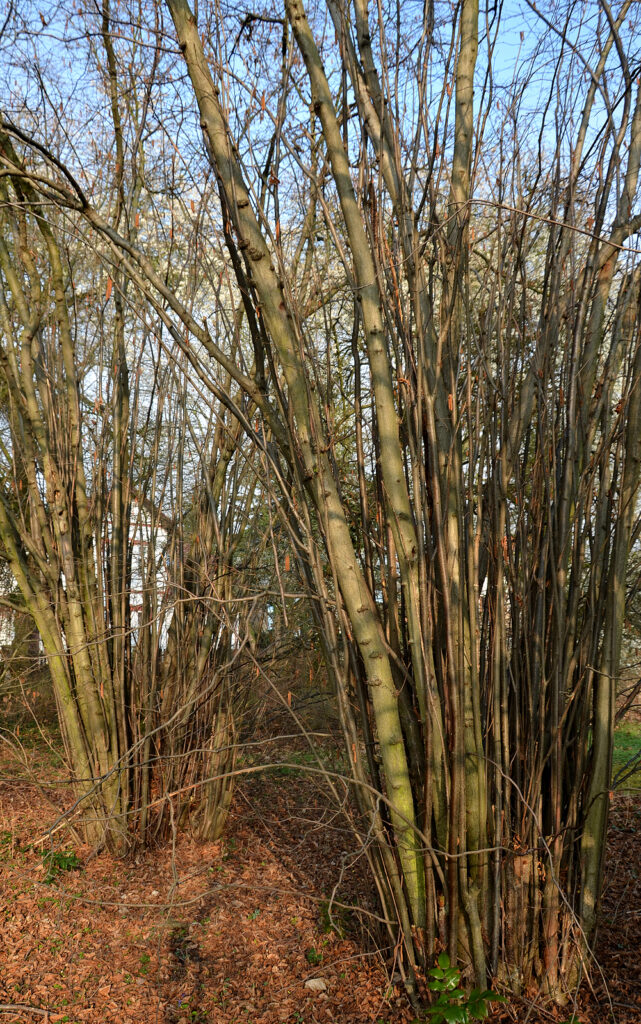Corylus — which includes filberts and hazelnuts–are grown in shrub borders and as specimen trees. Smaller hazels are best grown in shrub borders. Larger species and cultivars are excellent specimen trees.
Filberts and hazelnuts are usually thought of as trees grown for their edible nuts, but several are pleasing ornamental shrubs–particularly European filbert (Corylus avellana), ‘Contorta’–known as Harry Lauder’s Waling Stick, Turkish hazel (C. colurna), and C. maxima.
Corylus have separate male and female flowers. Female flowers are inconspicuous. Male Corylus produce showy yellow catkins on bare branches in winter or early spring.
Corylus is a genus of about 15 species of deciduous trees and shrub native to woodlands in the Northern temperate regions.

Get to know Corylus
- Plant type: Deciduous trees and shrubs
- Growing zones and range: Zones 4 to 9
- Hardiness: Hardy to Zone 4
- Height and width: 4 to 15 feet (1.2-4.5m) tall and wide
- Growth rate: Medium
- Form and habit: Upright, sometimes multi-stemmed
- Foliage: Colorful foliage, unusual forms and delicate; leaves are roundish to oval, with toothed margins
- Flowers: Pendulous, scaly flower clusters called catkins; the male catkins, which develop in fall and half on the plants during winter, expand in early spring to a length of 2.5 inch (6.4cm) and become bright yellow with pollen; the inconspicuous female flowers are followed by .8 inch (2cm) seed husks that hold the .5 inch (1.3cm) roundish or egg-shaped nuts within them; they ripen in early fall
- Fruits: Cultivars of several species produce edible nuts
- Bloom time: Fall
- Uses: Shrub borders; larger species are excellent specimen trees
- Common name: Filbert, Hazelnut
- Botanical name: Corylus
- Family name: Betulaceae
- Origin: North America, Europe, and Asia
Where to plant Corylus
- Plant Corylus in full sun or light shade.
- Corylus will grow in almost any soil, but prefers fertile, well-drained soil and can adapt to alkaline soils.

When to plant Corylus
- Set container-grown Corylus in the garden in spring or autumn.
- Sow seed in a seedbed as soon as they are ripe.
Planting and spacing Corylus
- Set container-grown Corylus in the garden in spring and autumn.
- Sow seed 1/4 inch deep in evenly prepared soil.
How to water and feed Corylus
- Give Corylus regular water, except where noted.
- Feed Corylus with an all-purpose organic fertilizer in spring.
How to care for Corylus
- Pruning Corylus is rarely required except to remove suckers, fast-growing stems that rise from the bases of old plants. These can be cut at any time.
- In late winter the first year after planting, head back Corylus stems to encourage branching. Then in following winters, head back side shoots and tips by about a third. Removing older branches in the center of the shrub will stimulate growth, reduce chances of disease, and make harvesting easier.
- Remove vigorous suckers to ground level.
Corylus pests and diseases
- Powdery mildew, blight, canker, dieback, mushroon root rot, fungal spots, and rust can be problems.
- Bud mites, tent caterpillars, and webworms can attack Corylus.
- Squirrels tend to harvest Corylus nuts before the homeowner can get to the chance.
Corylus propagation
- Propagate Corylus species by stratifying seeds. Sow seed in a seedbed as soon as they are ripe.
- Corylus can be started by digging up and replanting the suckers or by forcing a branch to grow roots by the method known as ground layering.

Corylus varieties to grow
- Corylus americana, American filbert, this eastern U.S. native is a multistemmed shrub growing to 15 feet (4.6m) and 12 feet (3.7m) wide. In early spring it produces prominent yellow-brown male catkins up to 3 inches (7.6cm) long. In fall you can collect the .5 inch (1.3cm) edible nuts. Zones 4 to 9.
- C. avellana, Hazelnut, European filbert, an upright suckering shrub 15-20 feet (4.6-6.1m) tall, this species is often used for commercial nut production. Drooping yellow catkins to 2.5 inches (6.4cm) appear in late winter.
- ‘Contorta’, also called Harry Lauder’s walking stick, has twisted, curly stems, good for dried arrangements and winter interest in the landscape. Look for clones of this plant grown from cuttings or layering, since grafted plants will produce uncurly suckers that spoil its silhouette. It is so unusual looking that it is best used alone as a garden accent. Zones 3 to 8.
- ‘Fusco-rubra’ (‘Atropurpurea’), to 10-15 feet (3.1-4.6m) high and wide, with 3-4 inches (7.6-10.2cm) leaves in reddish purple.
- C. avellana aurea, Golden-leaved hazelnut, grows 8-15 feet (2.4-4.6m) tall, has 4 inch (10.2cm) leaves that are bright yellow in spring and become greenish during the summer.
- C. colurna, Turkish filbert, commonly grown as an ornamental. Densely pyramidal when young and eventually maturing into a rounded or oval shape with low-hanging branches, this good-looking tree, which reaches 50 feet (15.2m) or more tall, should be used more often in North American landscapes. Yellowish tan male catkins dangle from the branches in late winter before the leaves unfold. The rounded or heart-shaped leaves are 3-6 inches (7.6-15.2cm) long, rather coarse, glossy, and dark green, with a double row of fine teeth at their margins. Fall color is usually undistinguished. Brown bark exfoliates into an attractive, rough-textured, brown-and-white pattern. Small nuts enclosed in bristly husks ripen in fall and may be messy but are eaten by wildlife. Plant as an easy-care formal lawn, urban, street, or seashore tree. Grow in full sun and any well-drained, acid to alkaline soil. It is drought, heat, and wind tolerant once established and performs well near the seashore, resisting wind and salt spray. Remove lower branches if desired. Eastern filbert blight can be a problem in some areas; otherwise pest-free. From southeastern Europe and southwestern Asia. Zones 5 to 8.
- C. cornuta, Beaked filbert, a small shrub, 4-8 feet (1.2-2.4m) tall and wide, native from Canada to Missouri and Georgia, with 1 inch (2.5cm) catkins. It gets common name from a “bleak” that forms around .5 inch (1.3cm) nuts. Zones 4 to 8.
- C. maxima, native to southeastern Europe. One of the species grown for nuts. Suckering shrub 12-15 feet (3.7-4.6m) high; can be trained as small tree.
- C. maxima purpurea, Purple-leaved hazelnut, Purple giant filbert, grows 12-20 feet (3.7-6.1m) tall and 15 feet (4.6m) wide. It has 5 inch (12.7cm) leaves that, as the name implies, are dark purple; they hold their color throughout the summer and fall. Zones 4 to 8.



